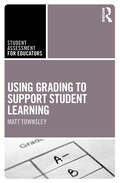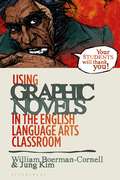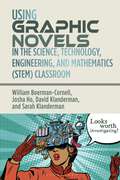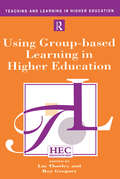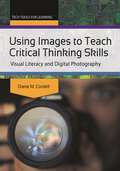- Table View
- List View
Using Games and Simulations for Teaching and Assessment: Key Issues
by Harold F. O'Neil Eva L. Baker Ray S. PerezUsing Games and Simulations for Teaching and Assessment: Key Issues comprises a multidisciplinary investigation into the issues that arise when using games and simulations for educational purposes. Using both theoretical and empirical analyses, this collection examines cognitive, motivational, and psychometric issues with a focus on STEM content. Unlike other research-based volumes that focus solely on game design or the theoretical basis behind gaming, this book unites previously disparate communities of researchers—from civilian to military contexts as well as multiple disciplines—to critically explore current problems and illustrate how instructionally effective games and simulations should be planned and evaluated. While computer-based simulations and games have the potential to improve the quality of education and training, Using Games and Simulations for Teaching and Assessment: Key Issues shows how the science of learning should underlie the use of such technologies. Through a wide-ranging yet detailed examination, chapter authors provide suggestions for designing and developing games, simulations, and intelligent tutoring systems that are scientifically-based, outcomes-driven, and cost-conscious.
Using Games and Simulations for Teaching and Assessment: Key Issues
by Harold F. O'Neil Eva L. Baker Ray S. PerezUsing Games and Simulations for Teaching and Assessment: Key Issues comprises a multidisciplinary investigation into the issues that arise when using games and simulations for educational purposes. Using both theoretical and empirical analyses, this collection examines cognitive, motivational, and psychometric issues with a focus on STEM content. Unlike other research-based volumes that focus solely on game design or the theoretical basis behind gaming, this book unites previously disparate communities of researchers—from civilian to military contexts as well as multiple disciplines—to critically explore current problems and illustrate how instructionally effective games and simulations should be planned and evaluated. While computer-based simulations and games have the potential to improve the quality of education and training, Using Games and Simulations for Teaching and Assessment: Key Issues shows how the science of learning should underlie the use of such technologies. Through a wide-ranging yet detailed examination, chapter authors provide suggestions for designing and developing games, simulations, and intelligent tutoring systems that are scientifically-based, outcomes-driven, and cost-conscious.
Using Games and Simulations in the Classroom: A Practical Guide for Teachers
by Henry Ellington Joannie Fowlie Monica GordonGames and simulations are an effective way of supporting the curriculum. This handbook demonstrates how to develop and use games and simulations in schools. It provides practical advice and guidance on how and when to use these as well as illustrative cases from nursery schools to secondary level.
Using Games and Simulations in the Classroom: A Practical Guide for Teachers
by Henry Ellington Joannie Fowlie Monica GordonGames and simulations are an effective way of supporting the curriculum. This handbook demonstrates how to develop and use games and simulations in schools. It provides practical advice and guidance on how and when to use these as well as illustrative cases from nursery schools to secondary level.
Using Games to Enhance Learning and Teaching: A Beginner's Guide
by Nicola Whitton Alex MoseleyUsing Games to Enhance Learning and Teaching provides educators with easy and practical ways of using games to support student engagement and learning. Despite growing interest in digital game-based learning and teaching, until now most teachers have lacked the resources or technical knowledge to create games that meet their needs. The only realistic option for many has been to use existing games which too often are out of step with curriculum goals, difficult to integrate, and require high-end technology. Using Games to Enhance Learning and Teaching offers a comprehensive solution, presenting five principles for games that can be embedded into traditional or online learning environments to enhance student engagement and interactivity. Extensive case studies explore specific academic perspectives, and featured insights from professional game designers show how educational games can be designed using readily accessible, low-end technologies, providing an explicit link between theory and practice. Practical in nature, the book has a sound theoretical base that draws from a range of international literature and research.
Using Games to Enhance Learning and Teaching: A Beginner's Guide
by Nicola Whitton Alex MoseleyUsing Games to Enhance Learning and Teaching provides educators with easy and practical ways of using games to support student engagement and learning. Despite growing interest in digital game-based learning and teaching, until now most teachers have lacked the resources or technical knowledge to create games that meet their needs. The only realistic option for many has been to use existing games which too often are out of step with curriculum goals, difficult to integrate, and require high-end technology. Using Games to Enhance Learning and Teaching offers a comprehensive solution, presenting five principles for games that can be embedded into traditional or online learning environments to enhance student engagement and interactivity. Extensive case studies explore specific academic perspectives, and featured insights from professional game designers show how educational games can be designed using readily accessible, low-end technologies, providing an explicit link between theory and practice. Practical in nature, the book has a sound theoretical base that draws from a range of international literature and research.
Using Generative AI Effectively in Higher Education: Sustainable and Ethical Practices for Learning, Teaching and Assessment (SEDA Focus Series)
by Peter Hartley Sue Beckingham Jenny Lawrence Stephen PowellUsing Generative AI Effectively in Higher Education explores how higher education providers can realise their role and responsibility in harnessing the power of generative artificial intelligence (GenAI) ethically and sustainably.This rich collection of established and evaluated practices from across global higher education offers a practical guide to leading an agile institutional response to emerging technologies, building critical digital literacy across an entire institution, and embedding the ethical and sustainable use of GenAI in teaching, learning, and assessment. Including reflections from stakeholders testifying to the value of the approaches outlined, the book examines how higher education can equip staff and students with the critical-digital literacy necessary to use GenAI in work, study, and social life responsibly and with integrity. It provides an evidence-based resource for any kind of higher education (HE) provider (modern, college-based, and research-focused) looking for inspiration and approaches which can build GenAI capability and includes chapters on the development of cross-institutional strategy, policies and processes, pedagogic practices, and critical-digital literacy.This resource will be invaluable to educational leaders, educational developers, learning developers, learning technologists, course administrators, quality assurance staff, and HE teachers wishing to embrace and adapt to a GenAI-enabled world.
Using Generative AI Effectively in Higher Education: Sustainable and Ethical Practices for Learning, Teaching and Assessment (SEDA Focus Series)
Using Generative AI Effectively in Higher Education explores how higher education providers can realise their role and responsibility in harnessing the power of generative artificial intelligence (GenAI) ethically and sustainably.This rich collection of established and evaluated practices from across global higher education offers a practical guide to leading an agile institutional response to emerging technologies, building critical digital literacy across an entire institution, and embedding the ethical and sustainable use of GenAI in teaching, learning, and assessment. Including reflections from stakeholders testifying to the value of the approaches outlined, the book examines how higher education can equip staff and students with the critical-digital literacy necessary to use GenAI in work, study, and social life responsibly and with integrity. It provides an evidence-based resource for any kind of higher education (HE) provider (modern, college-based, and research-focused) looking for inspiration and approaches which can build GenAI capability and includes chapters on the development of cross-institutional strategy, policies and processes, pedagogic practices, and critical-digital literacy.This resource will be invaluable to educational leaders, educational developers, learning developers, learning technologists, course administrators, quality assurance staff, and HE teachers wishing to embrace and adapt to a GenAI-enabled world.
Using Grading to Support Student Learning (Student Assessment for Educators)
by Matt TownsleyUsing Grading to Support Student Learning offers an accessible foundation for using grading practices to support student learning through classroom assessment. Purposeful, defensible grading and reporting mechanisms cannot be neglected in today’s reform climate, and new approaches are needed to understand and refine the roles of homework, formative and summative assessments, and standards across grade levels. Evidence-based and full of illustrative examples, this book bridges research and theory on grading and assessment with classroom practices for pre-service and in-service teachers and fresh perspectives for educational researchers studying grading practices.
Using Grading to Support Student Learning (Student Assessment for Educators)
by Matt TownsleyUsing Grading to Support Student Learning offers an accessible foundation for using grading practices to support student learning through classroom assessment. Purposeful, defensible grading and reporting mechanisms cannot be neglected in today’s reform climate, and new approaches are needed to understand and refine the roles of homework, formative and summative assessments, and standards across grade levels. Evidence-based and full of illustrative examples, this book bridges research and theory on grading and assessment with classroom practices for pre-service and in-service teachers and fresh perspectives for educational researchers studying grading practices.
Using Graphic Novels in the English Language Arts Classroom
by William Boerman-Cornell Jung KimThere is an increasing trend in teachers using graphic novels to get their students excited about reading and writing, using both original stories and adaptations of classic works by authors such as Homer, Shakespeare, and the Brontes. However, there is surprisingly little research available about which pedagogies and classroom practices are proven to be effective. This book draws on cutting-edge research, surveys and classroom observations to provide a set of effective methods for teaching with graphic novels in the secondary English language arts classroom. These methods can be applied to a broad base of uses ranging from understanding literary criticism, critical reading, multimodal composition, to learning literary devices like foreshadowing and irony.The book begins by looking at what English language arts teachers hope to achieve in the classroom. It then considers the affordances and constraints of using graphic novels to achieve these specific goals, using some of the most successful graphic novels as examples, including Maus; Persepolis; The Nameless City; and American Born Chinese and series such as Manga Shakespeare. Finally, it helps the teacher navigate through the planning process to figure out how to best use graphic novels in their own classroom. Drawing on their extensive teaching experience, the authors offer examples from real classrooms, suggested lesson plans, and a list of teachable graphic novels organized by purpose of teaching.
Using Graphic Novels in the English Language Arts Classroom
by William Boerman-Cornell Jung KimThere is an increasing trend in teachers using graphic novels to get their students excited about reading and writing, using both original stories and adaptations of classic works by authors such as Homer, Shakespeare, and the Brontes. However, there is surprisingly little research available about which pedagogies and classroom practices are proven to be effective. This book draws on cutting-edge research, surveys and classroom observations to provide a set of effective methods for teaching with graphic novels in the secondary English language arts classroom. These methods can be applied to a broad base of uses ranging from understanding literary criticism, critical reading, multimodal composition, to learning literary devices like foreshadowing and irony.The book begins by looking at what English language arts teachers hope to achieve in the classroom. It then considers the affordances and constraints of using graphic novels to achieve these specific goals, using some of the most successful graphic novels as examples, including Maus; Persepolis; The Nameless City; and American Born Chinese and series such as Manga Shakespeare. Finally, it helps the teacher navigate through the planning process to figure out how to best use graphic novels in their own classroom. Drawing on their extensive teaching experience, the authors offer examples from real classrooms, suggested lesson plans, and a list of teachable graphic novels organized by purpose of teaching.
Using Graphic Novels in the STEM Classroom
by Professor William Boerman-Cornell Josha Ho Professor David Klanderman Dr Sarah KlandermanThis book provides everything STEM teachers need to use graphic novels in order to engage students, explain difficult concepts, and enrich learning. Drawing upon the latest educational research and over 60 years of combined teaching experience, the authors describe the multimodal affordances and constraints of each element of the STEM curriculum. Useful for new and seasoned teachers alike, the chapters provide practical guidance for teaching with graphic novels, with a section each for Science, Technology, Engineering, and Mathematics. An appendix provides nearly 100 short reviews of graphic novels arranged by topic, such as cryptography, evolution, computer coding, skyscraper design, nuclear physics, auto repair, meteorology, and human physiology, allowing the teacher to find multiple graphic novels to enhance almost any unit. These include graphic novel biographies of Stephen Hawking, Jane Goodall, Alan Turing, Rosalind Franklin, as well as popular titles such as T-Minus by Jim Ottaviani, Brooke Gladstone's The Influencing Machine, Theodoris Andropoulos's Who Killed Professor X, and Gene Yang's Secret Coders series.
Using Graphic Novels in the STEM Classroom
by Professor William Boerman-Cornell Josha Ho Professor David Klanderman Dr Sarah KlandermanThis book provides everything STEM teachers need to use graphic novels in order to engage students, explain difficult concepts, and enrich learning. Drawing upon the latest educational research and over 60 years of combined teaching experience, the authors describe the multimodal affordances and constraints of each element of the STEM curriculum. Useful for new and seasoned teachers alike, the chapters provide practical guidance for teaching with graphic novels, with a section each for Science, Technology, Engineering, and Mathematics. An appendix provides nearly 100 short reviews of graphic novels arranged by topic, such as cryptography, evolution, computer coding, skyscraper design, nuclear physics, auto repair, meteorology, and human physiology, allowing the teacher to find multiple graphic novels to enhance almost any unit. These include graphic novel biographies of Stephen Hawking, Jane Goodall, Alan Turing, Rosalind Franklin, as well as popular titles such as T-Minus by Jim Ottaviani, Brooke Gladstone's The Influencing Machine, Theodoris Andropoulos's Who Killed Professor X, and Gene Yang's Secret Coders series.
Using Group-based Learning in Higher Education
by Roy Roy Gregory Lin Lin ThorleyThe research papers and case studies contained in this volume explore the technique of group work in higher education. The contributors explore project work, self-development groups, the management of group projects, peer evaluation and learning-team techniques.
Using Group-based Learning in Higher Education (Teaching And Learning In Higher Education Ser.)
by Lin Thorley Roy GregoryThe research papers and case studies contained in this volume explore the technique of group work in higher education. The contributors explore project work, self-development groups, the management of group projects, peer evaluation and learning-team techniques.
Using History to Develop Thinking Skills at Key Stage 2
by Belle WallaceThis practical resource book presents ways in which teachers can help to develop children's problem solving and thinking skills through a range of history topics. The book contains classroom-based activities that have been tried and evaluated by teachers and children. Most importantly, the contributors also show how the skills developed through rigorous historical investigations can be used across all areas of the curriculum. Topics covered include a detailed account of a world history investigation on Ancient Egypt; teaching historical skills using artifacts; small group work on local history, the Vikings and the Second World War; working in depth on aspects of the Tudors; and developing writing skills through a study of the Romans.
Using History to Develop Thinking Skills at Key Stage 2
by Belle WallaceThis practical resource book presents ways in which teachers can help to develop children's problem solving and thinking skills through a range of history topics. The book contains classroom-based activities that have been tried and evaluated by teachers and children. Most importantly, the contributors also show how the skills developed through rigorous historical investigations can be used across all areas of the curriculum. Topics covered include a detailed account of a world history investigation on Ancient Egypt; teaching historical skills using artifacts; small group work on local history, the Vikings and the Second World War; working in depth on aspects of the Tudors; and developing writing skills through a study of the Romans.
Using ICT in Inquiry-Based Science Education (SpringerBriefs in Education)
by António M. Rodrigues Geraldo W. Rocha Fernandes Carlos Alberto Rosa FerreiraThis book analyzes the main Information and Communication Technologies (ICT) used in science education and the main theoretical approaches that support science education mediated by ICT in order to show how digital technologies can be employed in Inquiry-Based Science Education. It presents the results of a comprehensive review of studies focusing both on the use and effects of digital technologies in science education and on the different theoretical approaches that support the use of ICTs in science teaching.By doing so, the book provides a useful summary of the current research in the field and a strong analysis of its limitations. It concludes that there are few studies that report strategies and didactics for the practical use of ICT in science classes and that the use of ICT in science education can’t be seen as an isolated action without a theoretical basis to support it. Based on these conclusions, the volume identifies the main ICTs used in inquiry activities, the main steps in inquiry activities used in science education and their approaches to the use of ICT. It shows that the use of ICT in Inquiry-Based Science Education allows students to develop more active work styles, improved attitudes towards science, better conceptual and theoretical understanding, improved reasoning, better modelling capabilities, and improved teamwork, along with improvements in other abilities. Using ICT in Inquiry-Based Science Education will be a valuable resource for science teachers and science teacher educators looking for an introductory text that presents an overview of the scientific research analyzing the implementation of digital technologies in science teaching and that provides useful insights to all educators interested in using digital technologies to introduce their students in the world of scientific inquiry and research.
Using ICT in Primary Mathematics: Practice and Possibilities
by Bob Fox Ann Montague-Smith Sarah WilkesFirst Published in 2000. Routledge is an imprint of Taylor & Francis, an informa company.
Using ICT in Primary Mathematics: Practice and Possibilities
by Bob Fox Ann Montague-Smith Sarah WilkesFirst Published in 2000. Routledge is an imprint of Taylor & Francis, an informa company.
Using ICT in the Primary School
by Carol Elston`A valuable resource for all primary practitioners. This covers everything from turning on the computer, to the history of Government funding for ICT...I would recommend this as a valuable addition to staffroom resources and a friendly and accessible reference for trainee teachers' - TES website `I have really enjoyed reading this book, it is written in a clear, non-patronising way and the use of technical jargon is avoided. The information given is really informative and the activities are ones I could genuinely use during an ICT lesson' - Janine Thornhill, Higher Level Teaching Assistant (with ICT specialism) Looking for an easy-to-read guide to embedding ICT within the primary curriculum? This book is packed full of practical examples and suggested activities to help the busy teacher or teaching assistant. It provides the reader with the subject knowledge they need to confidently teach ICT skills and use ICT in planning, preparation and assessment. The focus is on the difference between learning ICT skills and applying ICT, with the emphasis placed on integrating ICT into the curriculum and learning by doing. Key features include: - practical guidance; - activities incorporating word processing, database, spreadsheet, graphics, control software and Internet use (including email); - advice on how to meet Foundation Stage and the ICT QCA scheme objectives for each year of primary education. This is an invaluable resource for trainee teachers, HLTAs and TAs, established teachers, supply teachers, ICT Coordinators and all other educational professionals involved in teaching or supporting ICT within primary education.
Using Images to Teach Critical Thinking Skills: Visual Literacy and Digital Photography (Tech Tools for Learning)
by Diane M. CordellLearn how to teach visual literacy through photography—an easy way for you to combine student interest with resources at hand to enhance a key learning skill.Research indicates that 75 to 90 percent of classroom learning occurs through the visual system, making visual literacy a key component of information literacy and of critical thinking—a requirement throughout the Common Core standards. It's no surprise then that visual literacy is increasingly recognized as a competency that should be part of every student's skill set. Fortunately, this critical skill can be incorporated into existing curriculum, and this book shows you how to do just that. Written for K–12 classroom teachers and librarians, this all-you-need-to-know volume discusses the importance of visual literacy in education and examines how it helps address current learning standards. The book shows you how to use photography and digital images to cultivate critical thinking, inquiry, and information literacy; provides examples of the use of photographic images in the classroom and in "real life"; and addresses how students can be ethical practitioners in a digital world. In addition, the book includes sample lessons you can easily implement, regardless of your level of technical and photographic expertise. A resource list of photo editing, curation, and museum sites is included.
Using Images to Teach Critical Thinking Skills: Visual Literacy and Digital Photography (Tech Tools for Learning)
by Diane M. CordellLearn how to teach visual literacy through photography—an easy way for you to combine student interest with resources at hand to enhance a key learning skill.Research indicates that 75 to 90 percent of classroom learning occurs through the visual system, making visual literacy a key component of information literacy and of critical thinking—a requirement throughout the Common Core standards. It's no surprise then that visual literacy is increasingly recognized as a competency that should be part of every student's skill set. Fortunately, this critical skill can be incorporated into existing curriculum, and this book shows you how to do just that. Written for K–12 classroom teachers and librarians, this all-you-need-to-know volume discusses the importance of visual literacy in education and examines how it helps address current learning standards. The book shows you how to use photography and digital images to cultivate critical thinking, inquiry, and information literacy; provides examples of the use of photographic images in the classroom and in "real life"; and addresses how students can be ethical practitioners in a digital world. In addition, the book includes sample lessons you can easily implement, regardless of your level of technical and photographic expertise. A resource list of photo editing, curation, and museum sites is included.
Using Imagination, Mindful Play and Creative Thinking to Support Wellbeing and Resilience in Children (Helping Children to Build Wellbeing and Resilience)
by Deborah PlummerForms part of JKP's 'Helping Children to Improve Wellbeing and Resilience' seriesUsing a model of 'mindfulness play' to help children to achieve wellbeing, this book encourages children to build awareness of their inner and outer worlds. This multidimensional approach, designed and developed by an experienced speech and language therapist, centres on the importance of play activities to build psychological, emotional and social wellbeing and looks into the pivotal role adults play in supporting a child's self-esteem. By promoting the growth of self-esteem in different areas of a child's life, the book shows how adults help children to establish a firm basis of wellbeing from which they can flourish.The accompanying activity booklets that demonstrate the practical application of this approach are:· Helping Children to Manage Transitions· Helping Children to Manage Stress· Helping Children to Manage Friendships· Helping Children to Manage Anger· Helping Children to Build Self-Confidence · Helping Children to Build their Communication SkillsThe strategies in this ebook guide show how imagination, mindfulness and creativity can enhance our daily interactions with children, and the activity books encourage children to build life skills through structured experiences and through experimenting with different ways of thinking and 'being'.




